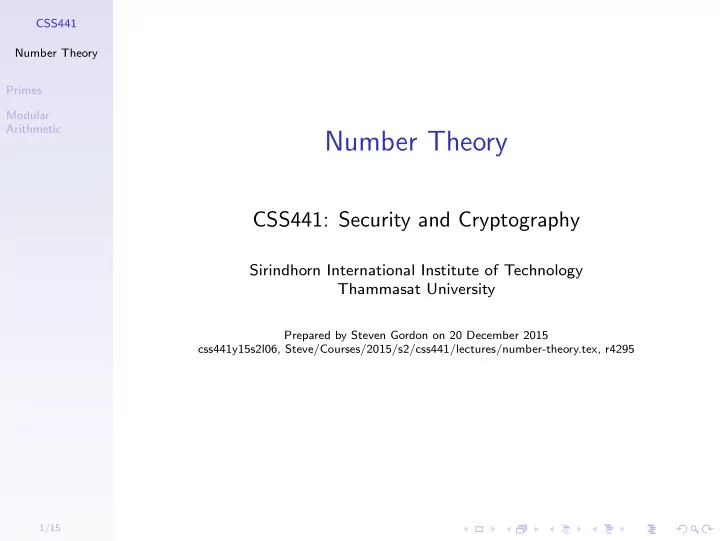

CSS441 Number Theory Primes Modular Arithmetic Number Theory CSS441: Security and Cryptography Sirindhorn International Institute of Technology Thammasat University Prepared by Steven Gordon on 20 December 2015 css441y15s2l06, Steve/Courses/2015/s2/css441/lectures/number-theory.tex, r4295 1/15
CSS441 Contents Number Theory Primes Modular Arithmetic Divisibility and Prime Numbers Modular Arithmetic 2/15
CSS441 Divisibility Number Theory ◮ b divides a if a = mb for some m , where a , b and m are Primes integers Modular ◮ b | a Arithmetic ◮ b is a divisor of a ◮ gcd( a , b ): greatest common divisor of a and b ◮ Euclidean algorithm can find gcd ◮ Two integers, a and b , are relatively prime if gcd( a , b ) = 1 3/15
CSS441 Prime Numbers Number Theory ◮ An integer p > 1 is a prime number if and only if its Primes only divisors are ± 1 and ± p Modular Arithmetic ◮ Any integer a > 1 can be factored as: a = p a 1 2 × p a 2 2 × · · · × p a t t where p 1 < p 2 < . . . < p t are prime numbers and where each a i is a positive integer 4/15
CSS441 Primes Under 2000 Number Theory Primes Modular Arithmetic 5/15
CSS441 Contents Number Theory Primes Modular Arithmetic Divisibility and Prime Numbers Modular Arithmetic 6/15
CSS441 Modular Arithmetic Number Theory ◮ If a is an integer and n is a positive integer, we define Primes a mod n to be the remainder when a is divided by n Modular Arithmetic ◮ n is called the modulus ◮ Two integers a and b are congruent modulo n if ( a mod n ) = ( b mod n ), which is written as a ≡ b (mod n ) (mod n ) operator maps all integers into the set of ◮ integers Z n = { 0 , 1 , . . . , ( n − 1) } ◮ Modular arithmetic performs arithmetic operations within confines of set Z n 7/15
CSS441 Properties of Modular Arithmetic Number Theory ◮ Rules of ordinary arithmetic involving addition, Primes subtraction, and multiplication also apply in modular Modular arithmetic Arithmetic [( a mod n ) + ( b mod n )] mod n = ( a + b ) mod n [( a mod n ) − ( b mod n )] mod n = ( a − b ) mod n [( a mod n ) × ( b mod n )] mod n = ( a × b ) mod n 8/15
CSS441 Division in Modular Arithmetic Number Theory ◮ a is additive inverse of b if a + b ≡ 0 (mod n ) Primes ◮ All integers have an additive inverse Modular ◮ a is multiplicative inverse of b if a × b ≡ 1 (mod n ) Arithmetic ◮ Not all integers have a multiplicative inverse ◮ a has a multiplicative inverse in (mod n ) if a is relatively prime to n ◮ Division: a ÷ b ≡ a × MultInverse ( b ) (mod n ) 9/15
CSS441 Fermat’s Theorem Number Theory ◮ Fermat’s Theorem (1): if p is prime and a is a positive Primes integer not divisible by p , then Modular Arithmetic a p − 1 ≡ 1 (mod p ) ◮ Fermat’s Theorem (2): if p is prime and a is a positive integer, then a p ≡ a (mod p ) 10/15
CSS441 Euler’s Theorem Number Theory ◮ Euler’s Totient Function, φ ( n ): the number of positive Primes integers less than n and relatively prime to n Modular ◮ φ (1) = 1 Arithmetic ◮ For prime p , φ ( p ) = p − 1 ◮ For primes p and q , and n = pq , φ ( n ) = ( p − 1) × ( q − 1) ◮ Euler’s Theorem (1): For every a and n that are relatively prime: a φ ( n ) ≡ 1 (mod n ) ◮ Euler’s Theorem (2): For positive integers a and n : a φ ( n )+1 ≡ a (mod n ) 11/15
CSS441 Logarithms in Modular Arithmetic Number Theory ◮ Exponentiation (mod n ): repeated multiplication Primes ◮ Logarithms in ordinary arithmetic: Modular Arithmetic b = a i i = log a ( b ) ◮ Logarithms in modular arithmetic (discrete logarithm): b = a i (mod p ) i = dlog a , p ( b ) ◮ A unique exponent i can be found if a is a primitive root of prime p ◮ If a is a primitive root of p then a , a 2 , a 3 , . . . , a p − 1 are distinct (mod p ) ◮ Only integers with primitive roots: 2, 4, p α , 2 p α where p is any odd prime and alpha is positive integer 12/15
CSS441 Powers of Integers, Modulo 19 Number Theory Primes Modular Arithmetic Credit: Table 8.3 in Stallings, Cryptography and Network Security , 5th Ed., Pearson 2011 13/15
CSS441 Discrete Logarithms, Modulo 19 Number Theory Primes Modular Arithmetic Credit: Table 8.4 in Stallings, Cryptography and Network Security , 5th Ed., Pearson 2011 14/15
CSS441 Complexity Number Theory Certain problems are computationally hard . . . Primes Integer Factorisation Modular Arithmetic ◮ If p and q are unknown primes, given n = pq , find p and q ◮ Largest RSA number factored into two primes is 768 bits (232 decimal digits) Euler’s Totient ◮ Given composite n , find φ ( n ) ◮ Harder than integer factorisation Discrete Logarithms ◮ Given b , a and p , find i such that i = dlog a , p ( b ) ◮ Comparable to integer factorisation 15/15
Recommend
More recommend